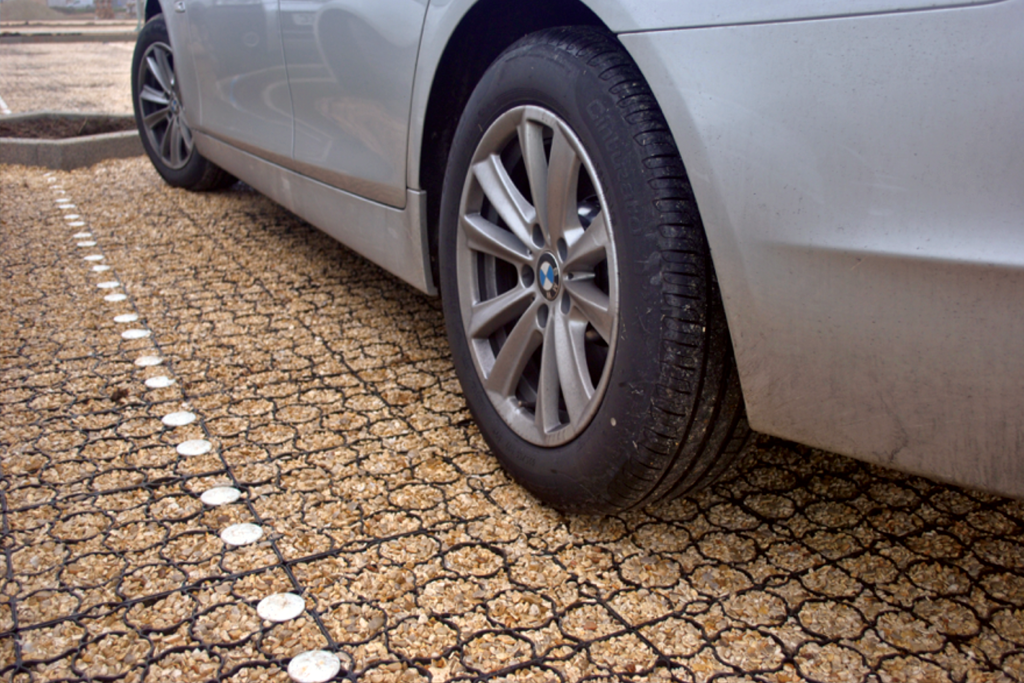From waste to a useable ground reinforcement: Recycling Plastic can solve many parking issues
By Elizabeth Hueftlein
We’ve suffered enough from cold-cracked, pot-holed, muddy parking lots with puddles the size of lakes. Let’s face it, the Canadian climate just isn’t very kind to concrete and asphalt. And I won’t even mention the problems we’re dealing with when it comes to storm water runoff. It’s time for a solution, and there is one on the market made of 100% recycled plastic. Plastic has such a bad reputation, yet we still use it in so many different situations. Why not use a recycled plastic solution to solve your parking issue?
Think about the things you put in your recycling bin; ever wondered where they go once they’re loaded into the recycling truck? I’ll give you a general overview of the process that our products go through to go from waste to a useable ground reinforcement product that is used in parking lots.
Step 1: Sortation – the contents of the recycling boxes go to a materials recovery facility (MRF), called a “murf”. There, the different types of plastic are sorted, baled, and crushed or compacted.
Step 2: Processing – a recycling facility takes in the baled plastic and processes it into either a granulate or pellet. This is also the stage that colour pigment can be added to the plastic (in the case of pelletizing).
Step 3: Manufacturing – The granulate, or pellets can be mixed with other plastics to a specific “recipe” and colour called masterbatch is added to the granulate. The pellets or granulate are then shaped into a value-added product by injection or intrusion moulding.
It’s important to note that not all plastics behave the same way. There is a considerable amount of science behind creating useful products from plastic waste. In 2016 one company with a facility in St. Clements, ON helped divert 47,000 metric tonnes of plastic from landfill. The great thing about recycled products is that they can be recycled again at the end of their lifespan. Plastic products can be recycled up to 50 times and although the manufacturers guarantee may be 15 years, the realistic lifespan is much longer. It’s also good to know that these products can be re-made into other useful products again and again.
There are two commonly used products for parking areas. One is a square injection moulded ground reinforcement grid. Typically, they come in one-square-foot pieces and come clipped together in one-metre squares. The second option is more heavy-duty version. It is ideal for areas where transport trucks need to manoeuvre around. These products are much thicker than their injection moulded counterparts. They typically have diamond shaped openings and are 8-10cm thick. The heavy-duty version has also been used in “living street” projects. Due to the large openings, they can be seeded with grass, making the area a green space. Both options are suitable for domestic use, car parking, and lightly trafficked roads. The heavy-duty version can handle vehicles weighing up to 60 metric tonnes, making it ideal for transport trucks. They’re also much lighter than the traditionally used concrete product, meaning more product can be shipped on a truck and they can be installed much more quickly.

Getting back to the Canadian climate I mentioned earlier, snowplows won’t rip out the 100% recycled plastic heavy-duty ground reinforcement grids. If there’s a corner not exactly flush with the others, it will just chip it off and carry on. So much better than the familiar problem with the concrete version where the plow rips the grid out of the ground.
How’s that for standing up to our Canadian winters? The versatility of the systems, which can be applied in a variety of applications opens up options for a more sustainable facility in this time of environmental conscientiousness.
For more information, contact HAHN Plastics (North America) Ltd. (519) 218-8800, www.hahnplastics.ca
COVER PHOTO: A heavy duty ground grid in use in Montreal
EMBEDDED PHOTO: A Canadian-made hanpave in a parking lot application





